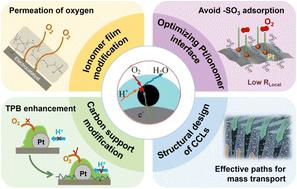当前位置:
X-MOL 学术
›
Green Chem.
›
论文详情
Our official English website, www.x-mol.net, welcomes your
feedback! (Note: you will need to create a separate account there.)
Optimized mass transfer in a Pt-based cathode catalyst layer for PEM fuel cells
Green Chemistry ( IF 9.3 ) Pub Date : 2024-03-14 , DOI: 10.1039/d3gc05033e Min Wang 1, 2 , Juejin Teng 1 , Shahid Zaman 3 , Shilin Zhang 1 , Xue Chen 2 , Kunye Zhang 1 , Xiuyue Wang 2 , Zhongtao Li 1 , Mingbo Wu 1, 2
Green Chemistry ( IF 9.3 ) Pub Date : 2024-03-14 , DOI: 10.1039/d3gc05033e Min Wang 1, 2 , Juejin Teng 1 , Shahid Zaman 3 , Shilin Zhang 1 , Xue Chen 2 , Kunye Zhang 1 , Xiuyue Wang 2 , Zhongtao Li 1 , Mingbo Wu 1, 2
Affiliation

|
Proton exchange membrane fuel cells have considerable potential to tackle climate and energy crises due to their clean and efficient energy conversion capabilities. However, their commercialization is hindered by the high costs associated with Pt-based electrocatalysts. Therefore, it is critical to reduce Pt loading without sacrificing the electrochemical performance. Yet, lower Pt loadings in the cathode catalyst layer result in mass transfer problems, particularly at high current densities, which substantially limit the development of low Pt PEM fuel cells. Herein, we highlight the mass transfer challenges and design strategies to address the problems such as ionomer film modification and catalyst layer interface optimization. We believe that this review will spur development in the design of catalyst layer structures to advance the development of PEM fuel cells.
中文翻译:

用于 PEM 燃料电池的 Pt 基阴极催化剂层中的优化传质
质子交换膜燃料电池由于其清洁高效的能源转换能力,在应对气候和能源危机方面具有巨大的潜力。然而,它们的商业化受到与铂基电催化剂相关的高成本的阻碍。因此,在不牺牲电化学性能的情况下减少 Pt 负载量至关重要。然而,阴极催化剂层中较低的 Pt 负载量会导致传质问题,特别是在高电流密度下,这大大限制了低 Pt PEM 燃料电池的发展。在此,我们重点介绍了传质挑战和设计策略,以解决离聚物膜改性和催化剂层界面优化等问题。我们相信,本次审查将刺激催化剂层结构设计的发展,从而推动质子交换膜燃料电池的发展。
更新日期:2024-03-14
中文翻译:

用于 PEM 燃料电池的 Pt 基阴极催化剂层中的优化传质
质子交换膜燃料电池由于其清洁高效的能源转换能力,在应对气候和能源危机方面具有巨大的潜力。然而,它们的商业化受到与铂基电催化剂相关的高成本的阻碍。因此,在不牺牲电化学性能的情况下减少 Pt 负载量至关重要。然而,阴极催化剂层中较低的 Pt 负载量会导致传质问题,特别是在高电流密度下,这大大限制了低 Pt PEM 燃料电池的发展。在此,我们重点介绍了传质挑战和设计策略,以解决离聚物膜改性和催化剂层界面优化等问题。我们相信,本次审查将刺激催化剂层结构设计的发展,从而推动质子交换膜燃料电池的发展。











































 京公网安备 11010802027423号
京公网安备 11010802027423号